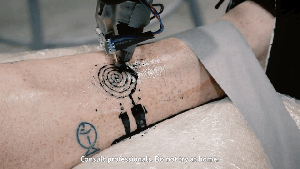French artists Pierre Emm and Johan da Silveira have developed a prototype of a tattoo robot during an Autodesk-sponsored Pier 9 residency in San Francisco.
There are several steps involved in the tattooing process when performed by a robot. First, a 3D scan of the targeted body part has to first be made. The tattoo design must be entered into custom computer software. When the robot is actually tattooing the person, the body part must be held extremely still – no movement can be made. In a trial, the person’s leg was duct-taped to the bench for the duration of the tattoo.
The tattoo robot is not yet commercially available, but the artists say that many tattoo artists are quite interested in purchasing a robot for their tattoo studios.
Tattoo artists are generally paid a commission by the tattoo studio, perhaps 50% of the price charged for the tattoo. Tattoo artists are typically self-employed, meaning that the tattoo studio does not pay the artists a wage or nor do they pay for the tattoo supplies.
A video of a robot tattooing a person’s leg can be viewed at https://vimeo.com/175491863
Questions
- Would the commissions paid to tattoo artists be considered a variable cost or a fixed cost for the tattoo studio?
- Would the cost of the tattoo robot be considered a variable cost or a fixed cost for the tattoo studio?
- Between the choice of using a tattoo artist versus a tattoo robot, which structure would have the most operating risk? Which structure would have the most potential reward? Explain.
- How would the break even point of a tattoo studio change if the studio were to replace some artists with a tattoo robot? Why?
Instructor Resources
These resources are provided to give the instructor flexibility for use of Accounting in the Headlines articles in the classroom. The blog posting itself can be assigned via a link to this site OR by distributing the student handout below. Alternatively, the PowerPoint file below contains a bullet point overview of the article and the discussion questions.
- Student handout (pdf) (word) (contains entire blog posting + discussion questions)
- PowerPoint file (brief article overview + discussion questions)


 September 22, 2016
September 22, 2016 


No comments yet... Be the first to leave a reply!